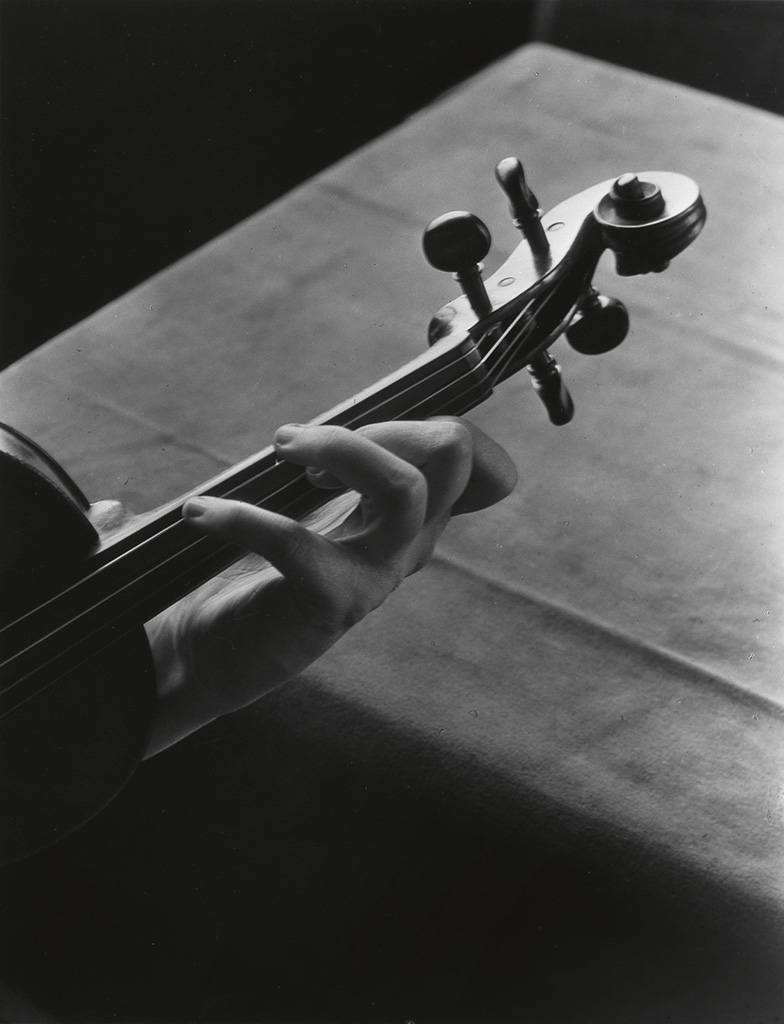Sale 2361 - Lot 122
Unsold
Estimate: $ 18,000 - $ 22,000
CUNNINGHAM, IMOGEN (1883-1976)
"Scroll of an Amati Violin." Silver print on warm-toned paper, 8 7/8x7 inches (22.5x17.8 cm.), with various notations relating to the reproduction of this image, in pencil, on verso. 1926
"Scroll of an Amati Violin." Silver print on warm-toned paper, 8 7/8x7 inches (22.5x17.8 cm.), with various notations relating to the reproduction of this image, in pencil, on verso. 1926
Additional Details
From Cunningham to the author David Prall; by descent to Prall's sister, Margaret C. Prall, music faculty at Mills College, Oakland; and then by purchase to a Private California Collector.
This print was used to illustrate David Prall's important book Aesthetic Judgement (1929). The author's first edition copy, with his book plate, is offered here. Prall was a lecturer at Harvard, and in the 1930s would become a mentor for Leonard Bernstein. (Robert Motherwell was also in that circle of artists and writers influenced by the thinker.) At Harvard Prall challenged academic traditions by insisting on the legitimacy of the every day, intuitive experience of a work of art, and on a multidisciplinary approach to artistic production and interpretation.
This exquisite photograph by Imogen Cunningham of an Amati violin showcases the photographer's brilliant use of light, as well as her refined modernist compositional style. Printed on the warm paper identified with her early work, this photograph depicts the violin's slender neck and graceful scroll. At the intersection of music, design, photography, and fine art, as well as the classical tradition and emerging modernist sensibility, this photographic object forms a delicate meeting point of the senses. A musician's fingers rest lightly on the violin, but below this classical gracefulness, a table forms abstracted planes of light and dark. The image ultimately transcends both its academic context and illustrative role to become a dynamic, beautiful self-sustaining artwork.
At a time when photographs were dismissed as an art form, Prall decidedly places photography within the context of other fine art mediums, including music, painting, and Medieval book arts. Prall addresses this directly: "But if an artist employs a sufficiently subtle camera instead of paint and brushes, there is no possible a priori reason why this tool, the function of which as a tool is representation, should not some day be part of the technical paraphernalia of the fine arts. There is nothing intrinsically spiritual in charcoal and paint-brushes, palettes and stretched canvases, red-lead and ochre and oil, to make them superior to lenses and shutters and gelatin-coated films. And there is no reason in the nature of things why subjects before a camera may not have expended upon them the whole power and skill of a great artist, or why, for the preservation of his vision of them, a camera of sufficient delicacy and contrivance might not be the best means" (198-99).
Amati violins, made from about 1538 to 1740, are today included in the same group of excellence as Stradivarius instruments, and are widely considered to have standardized the form.
This photograph was also reproduced in Vintage Photographs by Women of the 20s and 30s (Houk Gallery, 1988), 11.
This print was used to illustrate David Prall's important book Aesthetic Judgement (1929). The author's first edition copy, with his book plate, is offered here. Prall was a lecturer at Harvard, and in the 1930s would become a mentor for Leonard Bernstein. (Robert Motherwell was also in that circle of artists and writers influenced by the thinker.) At Harvard Prall challenged academic traditions by insisting on the legitimacy of the every day, intuitive experience of a work of art, and on a multidisciplinary approach to artistic production and interpretation.
This exquisite photograph by Imogen Cunningham of an Amati violin showcases the photographer's brilliant use of light, as well as her refined modernist compositional style. Printed on the warm paper identified with her early work, this photograph depicts the violin's slender neck and graceful scroll. At the intersection of music, design, photography, and fine art, as well as the classical tradition and emerging modernist sensibility, this photographic object forms a delicate meeting point of the senses. A musician's fingers rest lightly on the violin, but below this classical gracefulness, a table forms abstracted planes of light and dark. The image ultimately transcends both its academic context and illustrative role to become a dynamic, beautiful self-sustaining artwork.
At a time when photographs were dismissed as an art form, Prall decidedly places photography within the context of other fine art mediums, including music, painting, and Medieval book arts. Prall addresses this directly: "But if an artist employs a sufficiently subtle camera instead of paint and brushes, there is no possible a priori reason why this tool, the function of which as a tool is representation, should not some day be part of the technical paraphernalia of the fine arts. There is nothing intrinsically spiritual in charcoal and paint-brushes, palettes and stretched canvases, red-lead and ochre and oil, to make them superior to lenses and shutters and gelatin-coated films. And there is no reason in the nature of things why subjects before a camera may not have expended upon them the whole power and skill of a great artist, or why, for the preservation of his vision of them, a camera of sufficient delicacy and contrivance might not be the best means" (198-99).
Amati violins, made from about 1538 to 1740, are today included in the same group of excellence as Stradivarius instruments, and are widely considered to have standardized the form.
This photograph was also reproduced in Vintage Photographs by Women of the 20s and 30s (Houk Gallery, 1988), 11.

Exhibition Hours
Exhibition Hours
Aliquam vulputate ornare congue. Vestibulum maximus, libero in placerat faucibus, risus nisl molestie massa, ut maximus metus lectus vel lorem.


